Killer Ticks Wipe-out 75% of Moose in New Hampshire
| Arthur Dominic Villasanta | | May 18, 2016 07:41 AM EDT |
Killer moose ticks. Male (left) and female. A bloated tick engorged with moose blood. (Below) A moose victimized by moose ticks.
Nature has its own miniscule horde of bloodthirsty Draculas - the killer moose tick - that's destroyed 75 percent of the moose population in New Hampshire and is threatening moose herds in neighboring states and Canada.
The infamous moose tick or winter tick (Dermacentor albipictus) only preys on moose. At 15 millimeters in length, this tiny killer makes up for its puny size by attacking moose (Alces alces) by the thousands. Wildlife experts say up to 80,000 ticks can attack a single moose and suck-up so much blood the moose suffers greatly then dies in agony.
Like Us on Facebook
"It doesn't bode well for moose in the long term if we continue to have these short winters," said moose biologist Kristine Rines.
Experts say D. albipictus might be responsible for the sharp drop in the Eastern moose population throughout the southern half of their habitat.
Winter ticks thrive in milder and short winters such as those prevalent today because of climate change. New data also show 2015 was the second straight year moose calves suffered from a high mortality rate. But there's a twisted advantage to the large numbers of moose calves dying.
"As our moose numbers decline, the ticks will decline, as well," Rines said. "What we don't know is at what point will things level off."
Ticks weaken moose and make them vulnerable to starvation and attacks by wolves. Tick numbers are rising because of warm springs, warm summers and warm autumns. Five of the past six summers (2001-2006) have been the hottest summers in the history of a project studying these ticks.
Moose ticks, however, don't carry diseases that can be transmitted to humans. Experts claim meat from infested moose and other animals can be eaten as long as they're cooked well.
Tagsmoose tick, moose, New Hampshire
©2015 Chinatopix All rights reserved. Do not reproduce without permission
EDITOR'S PICKS
-

Did the Trump administration just announce plans for a trade war with ‘hostile’ China and Russia?
-

US Senate passes Taiwan travel bill slammed by China
-

As Yan Sihong’s family grieves, here are other Chinese students who went missing abroad. Some have never been found
-

Beijing blasts Western critics who ‘smear China’ with the term sharp power
-

China Envoy Seeks to Defuse Tensions With U.S. as a Trade War Brews
-

Singapore's Deputy PM Provides Bitcoin Vote of Confidence Amid China's Blanket Bans
-

China warns investors over risks in overseas virtual currency trading
-

Chinese government most trustworthy: survey
-

Kashima Antlers On Course For Back-To-Back Titles
MOST POPULAR
LATEST NEWS
Zhou Yongkang: China's Former Security Chief Sentenced to Life in Prison

China's former Chief of the Ministry of Public Security, Zhou Yongkang, has been given a life sentence after he was found guilty of abusing his office, bribery and deliberately ... Full Article
TRENDING STORY

China Pork Prices Expected to Stabilize As The Supplies Recover

Elephone P9000 Smartphone is now on Sale on Amazon India

There's a Big Chance Cliffhangers Won't Still Be Resolved When Grey's Anatomy Season 13 Returns

Supreme Court Ruled on Samsung vs Apple Dispute for Patent Infringement

Microsoft Surface Pro 5 Rumors and Release Date: What is the Latest?












